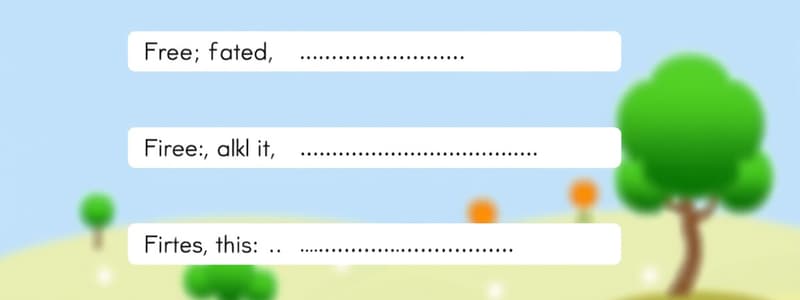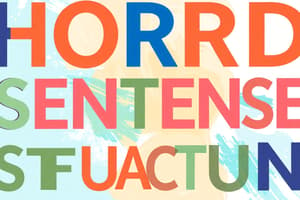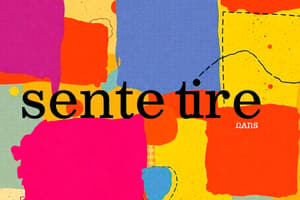Podcast
Questions and Answers
What ran very fast?
What ran very fast?
- The cat
- The dog (correct)
- The boy
- The teacher
Who had a party?
Who had a party?
- The boy (correct)
- The dad
- The girl
- The teacher
What did the teacher say?
What did the teacher say?
- Be quiet
- Sit down (correct)
- Go outside
- Stand up
Flashcards are hidden until you start studying
Study Notes
Vocabulary Flashcards Overview
- Collection of 32 flashcards featuring simple five-word sentences.
- Each card contains a sentence that is straightforward and illustrative of basic language concepts.
Sentence Themes and Contexts
- Sentences depict everyday activities, actions, and observations.
- Themes include pets (e.g., dogs and cats), sports (e.g., golf), education (e.g., what teachers say), and household interactions.
Key Sentences Highlighted
- "The dog ran very fast." illustrates action and speed.
- "The boy had a party." signifies social gatherings and events.
- "The teacher said, 'Sit down.'" emphasizes authority and classroom behavior.
Action-Oriented Language
- Many sentences involve verbs indicating movement or actions (e.g., ran, went, played, touched).
- Dynamic verbs help in developing comprehension of physical actions and interactions.
Descriptive Qualities
- Some sentences highlight adjectives to describe conditions (e.g., "The sun is very bright," "The song was very pretty").
- Use of adjectives enriches vocabulary by connecting sensory experiences with nouns.
Practical Life Skills
- Sentences such as "Please close the front door." and "Time to brush my teeth." focus on daily routines.
- Encourages understanding and following instructions.
Play and Leisure
- Flashcards also mention leisure activities (e.g., roller skating, playing with iPads).
- Encourages language skills related to fun and play.
Culinary Contexts
- Cards like "My mom cooked my dinner." and "Now the chocolate is melting." introduce food-related vocabulary.
- Connects family interactions with cooking experiences.
Requests and Questions
- Sentences such as "Can you get a lollipop?" and "May I have a lollipop?" teach politeness and making requests.
- Helps in understanding conversational norms and language structures.
Physical Descriptions
- Sentences like "The turtle is really slow." and "The mirror is hanging crooked." use physical attributes to convey meaning.
- Encourages visual literacy and descriptions.
Emotional and Aesthetic Appeal
- Sentences such as "The lollipop looks very yummy." show an emotional response to food.
- Promotes vocabulary related to taste and pleasure.
Miscellaneous Concepts
- Sentences explore various subjects including animals, family roles, and technology.
- Users gain exposure to diverse vocabulary and grammatical structure through simple sentences.
Studying That Suits You
Use AI to generate personalized quizzes and flashcards to suit your learning preferences.




